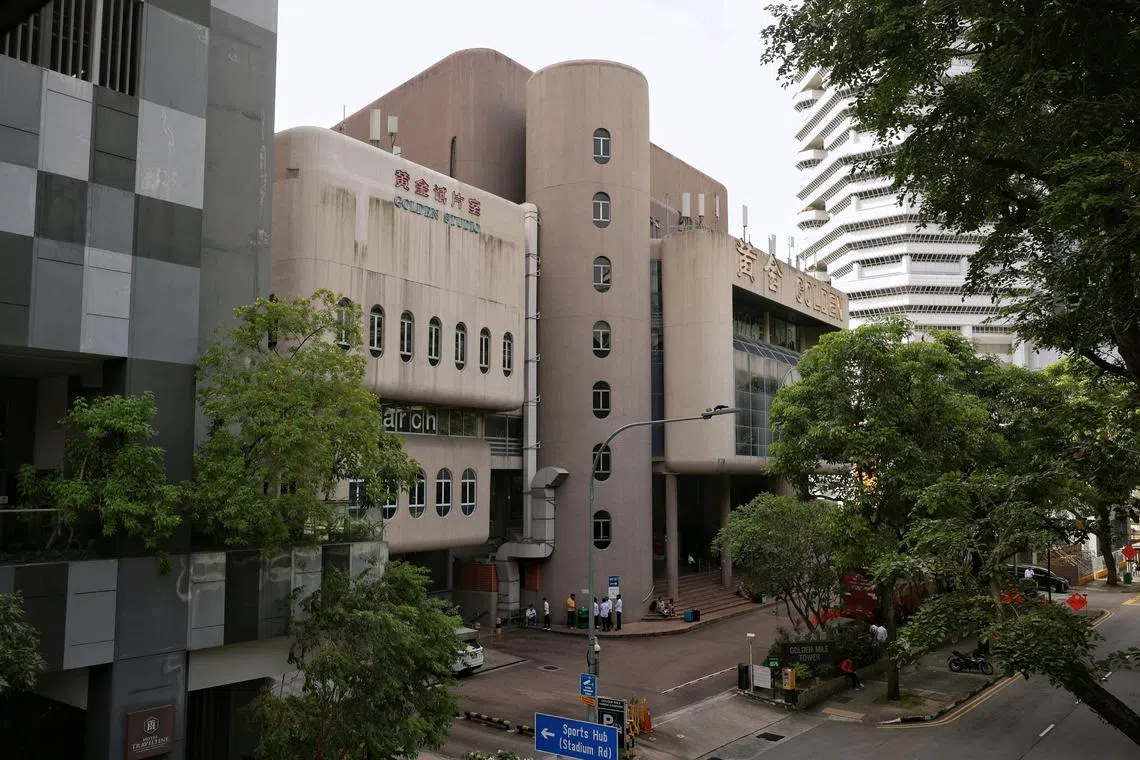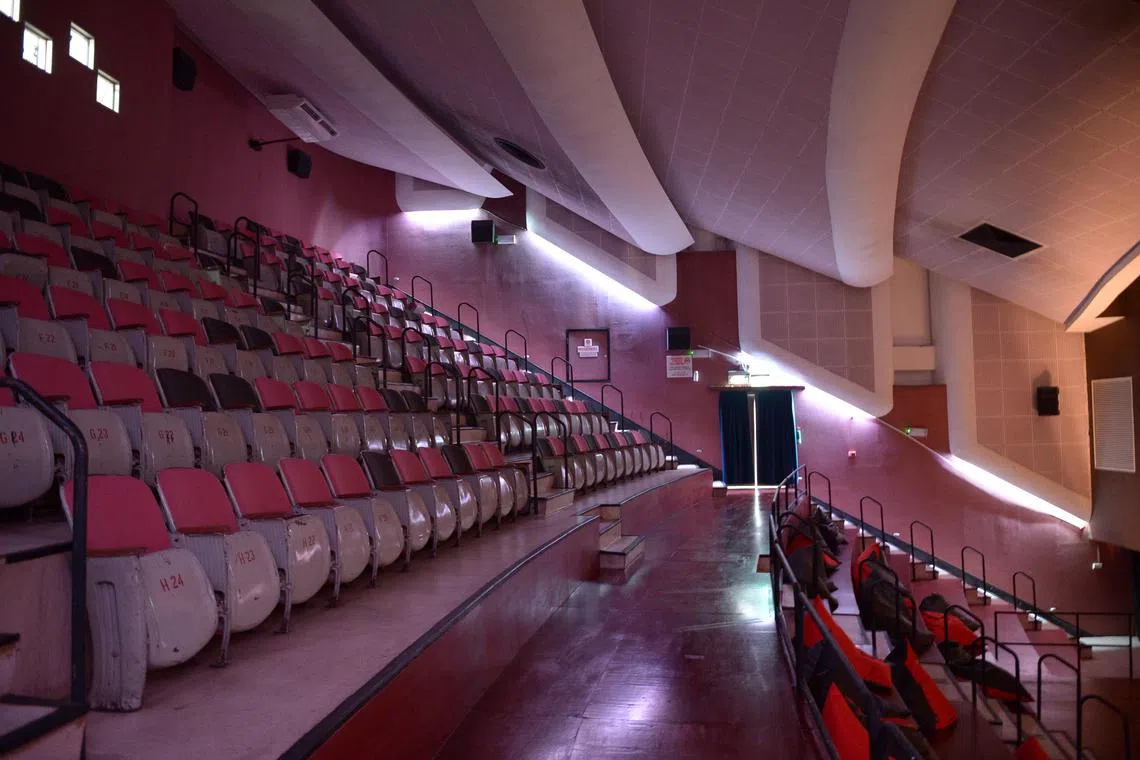URA makes rare offer to grant developers bonus floor area to keep Golden Mile Tower’s cinema block
Sign up now: Get ST's newsletters delivered to your inbox

Golden Mile Tower's cinema block, which could be conserved if its owners take up a development incentive offered by the URA.
ST PHOTO: KEVIN LIM
Follow topic:
SINGAPORE – The owners of Golden Mile Tower in Beach Road have been offered bonus gross floor area in the commercial complex’s redevelopment if they conserve its iconic cinema block.
The offer from the Urban Redevelopment Authority (URA) comes amid an ongoing collective sale exercise for the strata-titled development, which comprises an 18-storey office tower on top of a six-storey retail and carpark podium that houses the cinema block.
This latest move by the URA shows how the agency has in recent years looked to conserve large-scale strata-titled buildings, such as Golden Mile Complex.
In October 2021, the development, which is adjacent to Golden Mile Tower, was conserved
Golden Mile Tower’s sales agent, Ms Anna Tan, who is a business development director at Tag Realty, told The Straits Times on Jan 6 that the complex’s owners have permission to redevelop it into a 48,871.2 sq m development if at least the cinema block is kept. This results in a 25 per cent increase over the complex’s current 38,953.72 sq m gross floor area.
She said the permission from URA, received on Dec 23, has resulted in an extension of the collective sale exercise till Feb 12, after it began in August 2024 and was supposed to close on Dec 31.
This third collective sale attempt has a reserve price of $556 million, lower than the $650 million reserve price in November 2022, and $600 million in April 2023.
On Aug 7, 2024, Golden Mile Tower’s collective sale committee applied to the URA for the complex to be redeveloped as a 46,253 sq m mixed-use development, in the hope that an approved application would demonstrate the property’s redevelopment potential to potential buyers.
The proposal – which included a 35-storey office and residential tower, a 32-storey office and hotel tower, and a five-storey retail podium – was on Dec 23 rejected by the URA, with the agency making a counter-proposal to the committee with two options.
It may either redevelop Golden Mile Tower entirely, with a maximum building height of 145m and the gross floor area to be capped at the complex’s existing 38,953.72 sq m, or build a 48,871.2 sq m development with a maximum height of 164m if at least the existing cinema block is conserved.

Golden Mile Tower’s office tower (right) will not need to be retained under both the options offered by URA to the collective sale committee.
ST PHOTO: KEVIN LIM
Regardless of whether the cinema block is kept, the development that replaces Golden Mile Tower can be used for commercial, hotel and residential purposes.
Golden Mile Tower sits on a 0.87ha site with a 99-year lease that began on June 9, 1969.
When asked why URA offered incentives if the cinema block is conserved, an agency spokesperson said Golden Mile Tower is “a landmark which reflects the transformation of Beach Road over the years”.
“While redevelopment of the site can be considered, retaining the cinema block, with its distinctive facade that fronts Beach Road, would allow it to continue to be a familiar marker, positively contributing to the identity and history of the Beach Road area,” said the spokesperson, who did not give details on the conditions that may be imposed on the cinema block if it is conserved.

Retail spaces in Golden Mile Tower’s podium.
ST PHOTO: KEVIN LIM
Alongside Golden Mile Complex, which was conserved in October 2021, Golden Mile Tower is among the earliest results of independent Singapore’s efforts to rejuvenate its city centre, which had areas that the authorities in the 1960s said were “slum-ridden”.
The two developments are part of the “Golden Mile”, described in the Housing Board’s 1965 annual report as a row of “towering flats, office blocks and commercial buildings lining the main seafront overlooking Singapore harbour”.
Golden Mile Tower housed Golden Theatre and was developed by Chong Gay Theatres, which also developed Kallang Theatre. When Golden Theatre opened in 1973, it was among the largest cinemas in Singapore, placing Chong Gay alongside other entertainment giants such as Shaw and Cathay.
Golden Mile Tower’s cinema block is today occupied by The Projector and Carnival Cinemas.

A staircase that is popular with Instagrammers in Golden Mile Tower’s cinema block, pictured in 2015.
ST PHOTO: DESMOND WEE
Mr Ho Weng Hin, founding chairman of non-profit heritage group Docomomo Singapore, said the URA’s choice to nudge developers towards conserving the cinema block prioritises the retention of Golden Mile Tower’s most socially significant space, offering a good balance between intensifying development on the site and retaining a feature valued by the public.
He said Golden Theatre formed part of the strong theatre and entertainment heritage of Beach Road.
Two other cinemas there – Alhambra and Marlborough theatres – were demolished and replaced in the late 1970s by Shaw Towers, which housed Prince and Jade cinemas, he added.
Mr Edwin Loo, an associate director at real estate consultancy Cistri, said the team behind The Projector, which opened at Golden Mile Tower in 2014, has been among the most successful in “demonstrating to the wider public that previously neglected post-war modern buildings are worth celebrating and enjoying”.
“It would not be an exaggeration to say that the success of The Projector as an anchor tenant of Golden Mile Tower has played a significant role in raising awareness of Singapore’s modern architectural heritage among the wider public in recent years,” said Mr Loo.

One of The Projector’s theatres, pictured in June 2018.
PHOTO: ST FILE
If the cinema block is conserved, Mr Ho hopes its entertainment-based usage and character-defining elements, such as the raked seating, can be retained in a manner similar to the conserved Capitol Theatre, where performances are held and films can still be screened.
On whether the bonus gross floor area is sufficient to tip the scales in favour of conserving the cinema block, Mr Loo said there is no guarantee.
He said conservation will depend on the potential developers’ assessment of refurbishment and adaptive reuse costs, and the expectations of Golden Mile Tower’s subsidiary proprietors.
“The subsidiary proprietors need to understand that an incentive does not automatically result in windfall gains, given the risks and costs of redevelopment,” said Mr Loo.
“They will need to be pragmatic if they want to achieve a successful outcome at a price which ensures redevelopment remains financially viable.”
Ng Keng Gene is a correspondent at The Straits Times reporting on issues relating to land use, urban planning and heritage.


